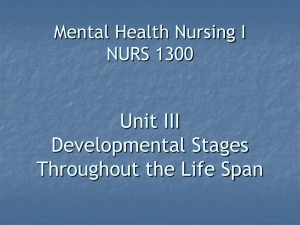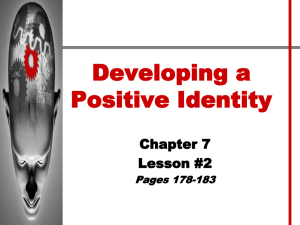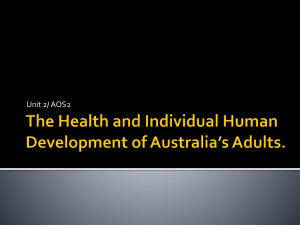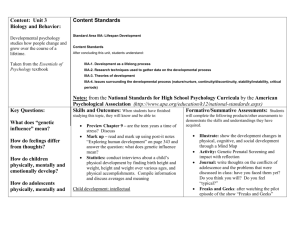Mental Health Nursing I
advertisement
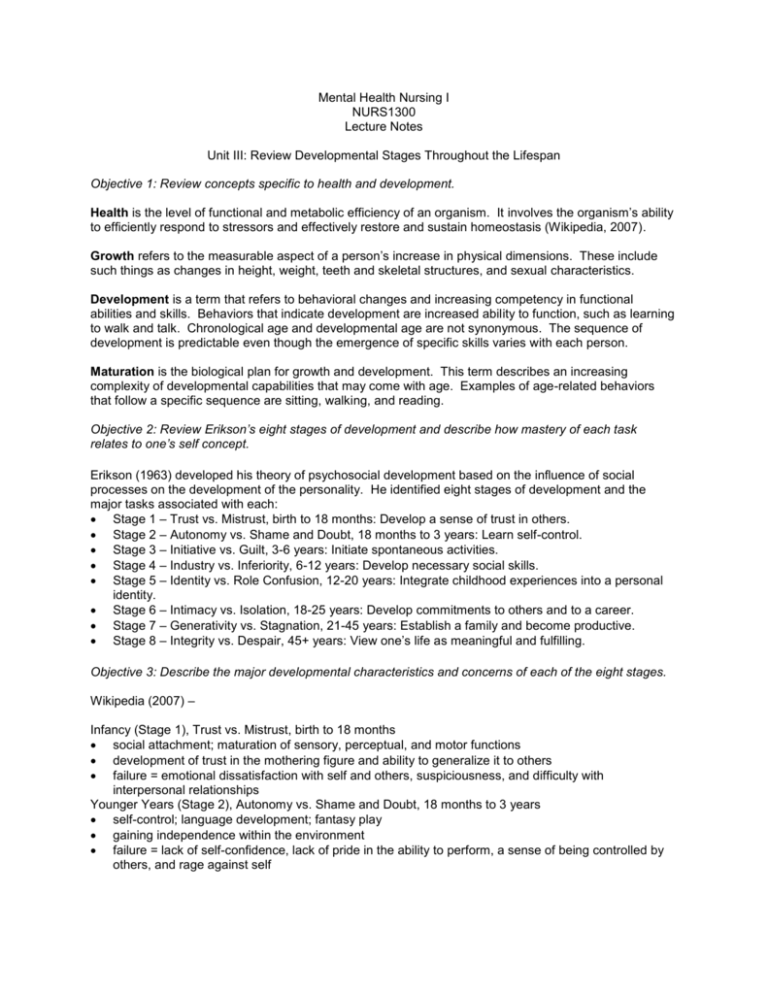
Mental Health Nursing I NURS1300 Lecture Notes Unit III: Review Developmental Stages Throughout the Lifespan Objective 1: Review concepts specific to health and development. Health is the level of functional and metabolic efficiency of an organism. It involves the organism’s ability to efficiently respond to stressors and effectively restore and sustain homeostasis (Wikipedia, 2007). Growth refers to the measurable aspect of a person’s increase in physical dimensions. These include such things as changes in height, weight, teeth and skeletal structures, and sexual characteristics. Development is a term that refers to behavioral changes and increasing competency in functional abilities and skills. Behaviors that indicate development are increased ability to function, such as learning to walk and talk. Chronological age and developmental age are not synonymous. The sequence of development is predictable even though the emergence of specific skills varies with each person. Maturation is the biological plan for growth and development. This term describes an increasing complexity of developmental capabilities that may come with age. Examples of age-related behaviors that follow a specific sequence are sitting, walking, and reading. Objective 2: Review Erikson’s eight stages of development and describe how mastery of each task relates to one’s self concept. Erikson (1963) developed his theory of psychosocial development based on the influence of social processes on the development of the personality. He identified eight stages of development and the major tasks associated with each: Stage 1 – Trust vs. Mistrust, birth to 18 months: Develop a sense of trust in others. Stage 2 – Autonomy vs. Shame and Doubt, 18 months to 3 years: Learn self-control. Stage 3 – Initiative vs. Guilt, 3-6 years: Initiate spontaneous activities. Stage 4 – Industry vs. Inferiority, 6-12 years: Develop necessary social skills. Stage 5 – Identity vs. Role Confusion, 12-20 years: Integrate childhood experiences into a personal identity. Stage 6 – Intimacy vs. Isolation, 18-25 years: Develop commitments to others and to a career. Stage 7 – Generativity vs. Stagnation, 21-45 years: Establish a family and become productive. Stage 8 – Integrity vs. Despair, 45+ years: View one’s life as meaningful and fulfilling. Objective 3: Describe the major developmental characteristics and concerns of each of the eight stages. Wikipedia (2007) – Infancy (Stage 1), Trust vs. Mistrust, birth to 18 months social attachment; maturation of sensory, perceptual, and motor functions development of trust in the mothering figure and ability to generalize it to others failure = emotional dissatisfaction with self and others, suspiciousness, and difficulty with interpersonal relationships Younger Years (Stage 2), Autonomy vs. Shame and Doubt, 18 months to 3 years self-control; language development; fantasy play gaining independence within the environment failure = lack of self-confidence, lack of pride in the ability to perform, a sense of being controlled by others, and rage against self Early Childhood (Stage 3), Initiative vs. Guilt, 3 to 6 years early moral development; self-esteem; group play; egocentrism development of a sense of purpose and the ability to initiate and direct own activities failure = feelings of inadequacy and guilt and the accepting of liability in situations for which he/she is not responsible Middle Childhood (Stage 4), Industry vs. Inferiority, 6 to 12 years friendship; skill learning; self-evaluation; team-play achievement of a sense of self-confidence by learning, competing, performing successfully, and receiving recognition from significant others, peers, and acquaintances failure = difficulty in interpersonal relationships caused by feelings of inadequacy Adolescence (Stage 5), Identity vs. Role Confusion, 12 to 20 years physical maturation; emotional development; membership in peer group; sexual relationships integration of tasks mastered in previous stages into a secure sense of self failure = self-consciousness, doubt, and confusion about one’s role in life Early Adulthood (Stage 6), Intimacy vs. Isolation, 18 to 25 years stable relationships; child-bearing; work formation of an intense, lasting relationship of a commitment to another person, a cause, an institution, or a creative effort failure = withdrawal, social isolation, aloneness, and the inability to form lasting, intimate relationships Middle Adulthood (Stage 7), Generativity vs. Stagnation, 21 to 45 years nurture close relationships; management of career and household; parenting achievement of life goals established for oneself while also considering the welfare of future generations failure = lack of concern for the welfare of others and total preoccupation with the self Late Adulthood (Stage 8), Integrity vs. Despair, 45+ years promote intellectual vigor; redirect energy to new roles and activities; develop a point-of-view about death review of one’s life and assignment of meaning from both positive and negative events; achieving a positive sense of self-worth failure = self-contempt and disgust with how life has progressed Objective 4: Describe the basic human needs in each level of Maslow’s Hierarchy of Needs. Refer to Maslow’s Hierarchy of Needs PowerPoint Objective 5: List the factors which influence the client’s ability to meet physiological and safety needs. Age – infants and young children, the frail elderly Cultural beliefs – affect attitudes toward health and illness Spirituality – may be an asset or a liability to the patient’s ability to cope with illness Self-concept – refers to the notions, beliefs, and convictions persons hold about themselves; patients’ perception of these changes and their ability or inability to cope with the changes may result in stress, fear, and anxiety Family/community resources – because of increasing stresses on the family unit, many families are not able to provide as much support as the patient may need; many of the functions once provided by families are being assumed by social institutions within the community Emotional responses to illness – coping methods utilized by patients and families may become maladaptive in the face of stress and fear; ineffective coping may evolve from a sense of helplessness or powerlessness Objective 6: Describe nursing measures that will assist the client in meeting physiological and safety needs. Appropriate nursing diagnoses for clients with compromised ability to meet physiological needs: Ineffective airway clearance Risk for aspiration Ineffective breathing pattern Altered nutrition, less (or more) than body requirements Constipation or Diarrhea Total urinary incontinence Fluid volume deficit Impaired mobility Sleep pattern disturbance Pain Impaired skin integrity Appropriate nursing diagnoses for clients with compromised ability to meet safety needs: Risk for falls/injury/infection Anxiety or Fear Memory impairment Confusion Objective 7: Discuss priority needs of the client. The lower needs in Maslow’s Hierarchy of Needs must be fulfilled before those at higher levels can be achieved. The basic needs for human functioning are the physiological needs, and safety and security needs (Wikipedia, 2007). Objective 8: Relate how self-esteem can affect the hospitalized individual. Hospitalization takes away the individual’s locus of control, which highly impacts self-esteem (Goodman, S. H., Cooley, E. L., Sewell, D. R., & Leavitt, N., 1994, Locus of control and self-esteem in depressed, low-income African-American women, Community Mental Health Journal, 30(3).
